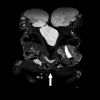Anesthetic Strategies and Challenges in the Separation of Pygopagus Conjoined Twins: A Case Report
- PMID: 39425462
- PMCID: PMC11502518
- DOI: 10.12659/AJCR.944776
Anesthetic Strategies and Challenges in the Separation of Pygopagus Conjoined Twins: A Case Report
Abstract
BACKGROUND Conjoined twins are a rare congenital anomaly with various types, depending on the connection site. Managing these cases requires a structured approach leading to separation surgery. This report provides a detailed description of the anesthetic strategies and challenges of pygopagous conjoined female twins who underwent 2 surgeries before separation at 17 weeks of age. CASE REPORT The female twins were conjoined at the sacral level (S4), with fused thecal sacs at L5 and cord tethering, with the conus terminating below L3 in both patients. They had separate rectal ampullae that fused into a single anal canal in the midline in a Y formation. The babies underwent 2 surgeries prior to separation: meningocele repair for twin B and anal canal dilation and sphincter mapping for both twins, followed by a ventriculoperitoneal shunt insertion for twin B. The separation surgery included dividing the bony vertebral fusions and dural sacs, untethering the spinal cords and nerves, and correctly allocating the intrapelvic muscles, guided by sphincter muscle mapping. Anesthesia was managed by 2 distinct teams each time, with duplicated equipment and color-coded medications to prevent errors. Due to the critical condition of twin B, general anesthesia was administered to her first. The report also addresses the challenges faced during the 3 surgical procedures. CONCLUSIONS Anesthetic management for pygopagus twins presents complex challenges. Despite limited experience with similar cases, successful management was achieved through planning, effective communication, and rehearsal of unfamiliar setups. Attention to detail and involvement of highly experienced teams were crucial to the success of the procedures.
Conflict of interest statement
Figures



Similar articles
-
[Anesthesic management during total organic separation of pygopagus conjoined twins].Rev Med Inst Mex Seguro Soc. 2018 Jan-Feb;56(1):106-111. Rev Med Inst Mex Seguro Soc. 2018. PMID: 29368903 Spanish.
-
Anesthetic planning and management for successful separation surgery of pygopagus conjoined twins: a multidisciplinary approach.J Surg Case Rep. 2025 Jun 14;2025(6):rjaf320. doi: 10.1093/jscr/rjaf320. eCollection 2025 Jun. J Surg Case Rep. 2025. PMID: 40521041 Free PMC article.
-
Ischiopagus and pygopagus conjoined twins: neurosurgical considerations.Childs Nerv Syst. 2004 Aug;20(8-9):640-51. doi: 10.1007/s00381-004-0987-2. Epub 2004 Jul 27. Childs Nerv Syst. 2004. PMID: 15278384 Review.
-
Separation of conjoined spinal cords in symmetrical pygopagus twins using intraoperative neuromonitoring: pearls and pitfalls.Childs Nerv Syst. 2023 Jul;39(7):1949-1955. doi: 10.1007/s00381-023-05912-5. Epub 2023 Mar 23. Childs Nerv Syst. 2023. PMID: 36949252 Free PMC article.
-
Spinal cord involvement in pygopagus conjoined twins: case report and review of the literature.Childs Nerv Syst. 2003 Mar;19(3):183-7. doi: 10.1007/s00381-002-0712-y. Epub 2003 Feb 22. Childs Nerv Syst. 2003. PMID: 12644871 Review.
References
Publication types
MeSH terms
LinkOut - more resources
Full Text Sources

